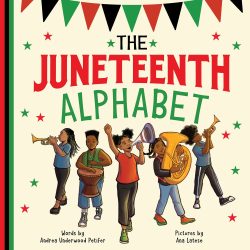

Review:
For decades, advocate and teacher Opal Lee fought to give Juneteenth the recognition it deserves. In 2021, her hard work and dedication came to fruition when the U.S. government, under President Joe Biden, officially recognized Juneteenth as a holiday. Author Andrea Underwood Petifer saw the recognition as an opportunity to educate both young children and adults about the history behind June 19th, which inspired her newly released children’s book, The Juneteenth Alphabet, with illustrations by Ana Latese.

Creating a story that explains 200 years of slavery, the Emancipation Proclamation that was meant to end all slavery, and the resistance of Texas to follow through with freeing the slaves for over two years is a lot for children (and quite honestly, adults) to grasp. Petifer has articulated the complexity in an alphabet book that breaks down the history from A to Z, starting with A is for Album (photo album that is) and Ancestors, and ending with Z is for Zeal, “an eagerness to endure after hearing no. It is brave, it is hope, it is joy, it is determination.”
Before the reader dives into the alphabet story, Petifer opens with the background of Juneteenth and how it’s regarded in African American communities as the second Independence Day. Four million African American people were not thought of when the Declaration of Independence was created, so this holiday celebrates the troops from the Union Army arriving in Galveston, Texas, two and a half years after independence was declared to free the remaining slaves.

Illustrator Ana Latese creates full-color jubilant art that beautifully complements the story using Procreate, iPad Pro, or Apple Pencil. The spreads feature brown and black hands held high, a red, white, and blue Juneteenth flag flown, and the African American community smiling while parading in the streets as gospel singers belt out the hymn Happy Day drawn above H is for Happy.

One of my favorite items in this book is the fact/info bubbles. The reader is asked to turn to their child and discuss questions that pertain to the topic on the page. Underneath the letter H, the bubble asks, “What are you feeling?” and then asks the child to share their thoughts with the reader. I think introducing social and emotional learning is a great way for kids to better understand this challenging and complex time in history. J is for Joy explains that when we express joy, we take back our story. Great words of wisdom!
Representing the letter O, Opal Lee, dressed in bright purple, stands at a podium with the White House behind her as she petitions the government to recognize the holiday. And, of course, the reader turns the page to S is for the Sounds of Songs that are Sweet and Savory; while T is for Talents and Traditions. Black rodeos, parades, and poetry readings prove there is more than just pain to the story.
The Juneteenth Alphabet concludes with a brief summary of terms (there are A LOT of new words for young readers). Children learn the meaning behind Equality, the quality of being the same. This was a very informative book, and I have to admit, I learned a lot about Juneteenth history that I was unaware of before reading this picture book. Parents can share this book over and over again, explaining the past while teaching their children the importance of treating all people the same. Latese creates a banner that reads “Fight for the Future,” and I think those are imperative words to ponder on June 19th. Happy Juneteenth, everyone!
- Reviewed by Ronda Einbinder
Related







